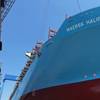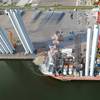Effort to Cut Ferry Deaths in Developing Nations
The original two-year MOU has been renewed indefinitely following major progress towards running demonstration projects in Bangladesh as a pilot for taking the safety initiative worldwide.
The new agreement was signed in London by IMO secretary-general Efthimios Mitropoulos and Interferry CEO Len Roueche. The trade association has IMO consultative status and a global membership of more than 200 leading operators and suppliers.
Mr Roueche said: “This commitment to our ongoing cooperation will be crucial in helping to prevent thousands of avoidable deaths. Domestic ferry operations are outside the IMO’s official mandate and Interferry has no members in the world’s poorest nations, but we each recognise a humanitarian duty to share the developed world’s wealth of experience.”
Initial funds have been raised for key elements of the Bangladesh pilot programme, which is based on proposals from a working group including the national maritime administration, local operators and other stakeholders.
Work is now well advanced on two of the main recommendations. A crew training DVD is being finalised for trial in early autumn and weather forecasting requirements are due to be assessed this summer by a team from the US National Oceanic and Atmospheric Administration (NOAA).
Meanwhile the Bangladeshi department of shipping has adopted improved procedures for vessel records and weather alerts; overseas funding has been sourced to computerise the ferry database and to promote safety regulations; and the IMO has signalled several new initiatives. These cover technical guidelines for vessel design, construction and operation as well as vessel refurbishment, accident investigation, dredging and terminal controls.
Crew training
The crew training DVD is being developed in conjunction with UK-based maritime training specialist Videotel, which has matched the IMO’s US$30,000 contribution to production costs.
A company consultant visited Bangladesh in March to review a draft of the course content with the director-general of shipping, ferry owners, crew representatives, shipbuilders and training school staff.
Draft text was prepared by all project partners and included input from Interferry members on three of the six modules – an introduction to hazards and risks, stability/safety measures and dealing with people. The other modules cover seaworthiness, navigation, collision avoidance, emergency response and weather/sea conditions.
Videotel is now creating the final version, which will feature extensive graphics to overcome lack of crew literacy. The programme will be tested in Bangladesh and the results presented at Interferry’s annual conference in Hong Kong in October, when further fundraising will be launched to roll out the one-day course.
Weather forecasting
In July a visiting team from the NOAA is due to meet Bangladeshi weather professionals to help improve the detection of hazardous conditions in river areas. The assessment will draw heavily on US experience of predicting tornado activity.
Further initiatives
Responsibility for vessel inspections, surveying and certification has been switched from several agencies and consolidated under the national shipping department to ensure accountability. A recent needs assessment has also clarified how enforcement capacity can be improved.
A Korean-funded project to computerise the department’s paper inventory of vessels will be completed in the next few months, while UK funding has been used to promote the implementation of safety regulations on domestic ferries. It is hoped that this will encourage international standards and more funding for Bangladeshi shipbuilders, who are beginning to produce bigger vessels for domestic use.
New IMO-led elements to the work in Bangladesh include demonstration refurbishments of sub-standard ferries, the development of safe operation and accident investigation procedures, a dredging study and, in addition, terminal design to prevent ferry overcrowding, which is linked to proposals for World Bank aid in building more terminals to relieve congestion.












